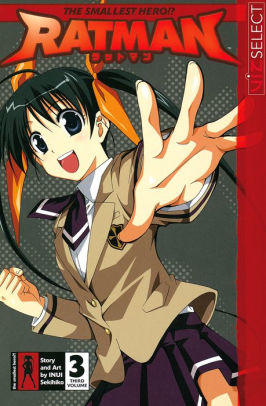Manga Review: Ratman, Vol. 3 by Sekihiko Inui
On an alternate Earth, methods have been found to give ordinary humans superpowers, and “superhero” is a profession. However, the processes involved are very expensive and out of range for the average working person. So most superheroes are sponsored by businesses and act as mascots for them. Of course, the bigger the business, the more powerful ability they can afford to give their hero. A major national corporation might have a A-Rank hero who is faster than a speeding bullet, more powerful than a locomotive and able to leap tall buildings in a single bound, while a small restaurant chain can only afford a E-Rank hero with a wimpy-sounding power.

Shuto Katsuragi has been a hero-worshipper since he was saved by Shiningman as a child, and his career ambition is to become a superhero. Unfortunately, he’s less than five feet tall at age fifteen, skinny and a wimp–not what any self-respecting corporation would be looking for in a mascot hero. But then Shuto and his classmate Mirea Mizushima are kidnapped. The hero who comes to rescue them is overcome, and gives Shuto his Append Gear transformation device. Shuto signs an agreement and uses the device to gain superpowers, rescuing Mirea.
Plot twist! It was all a trick, and Mirea was in on it the whole time. Shuto is now contractually obligated to work for the evil organization Jackal as the supervillain Ratman. This isn’t a career move Shuto wanted at all, but he’s trapped. And for an evil organization, Jackal’s members are awfully nice, while some of the professional heroes who belong to the Hero Association are jerks.
This superhero parody manga pokes fun at both American comic book and Japanese tokusatsu tropes. It was initially imported to the U.S. by Tokyopop, but left unfinished when that company collapsed. It appears that Viz has picked up the license.
At the start of this volume, Ratman is facing arrogant superhero ANKaiser in a burning building. ANKaiser is not heroically motivated, being in the business for fame, money and the chance to beat people up. In fact, he purposely sabotaged the skyscraper’s sprinkler system (after the fire started) so that it will be too dangerous for other heroes to enter and he can get solo credit for defeating Ratman.
In addition to his powers, ANKaiser is a skilled boxer which gives him an edge over the strong but untrained Ratman. After flooring the villain, ANKaiser takes a phone call and blows off looking for civilians who might still be trapped in the building. This unheroic behavior triggers Ratman’s berserk state, in which he becomes far more powerful at the cost of losing his conscious mind. He badly beats ANKaiser, then runs out of energy and reverts to his unconscious Shuto form just before they’re found and rescued.
Shuto wakes up in the hospital. Also there is Rio Kazaki, the daughter of the head of the Hero Association and Shuto’s sempai (upperclassman). She too wants to become a superhero but her strict father will not allow it, which doesn’t stop her rushing into danger to help people. She was the one who found Shuto. Mirea also stops by and is introduced to Rio; it’s clear she has a jealous reaction but Shuto is oblivious to this.
Based on ANKaiser’s fate, the Hero Association rescinds the “attack on sight” order against Ratman; they’re going to call in the big guns.
Shuto goes to Akihabara, a section of Tokyo known for stores selling tech and all things geeky, to get a thank-you gift for Rio. He finally succeeds in finding the thing he wants, a superhero movie collectible. Unfortunately, it is stolen by a gang of bag-snatchers. Shuto is aided by the local heroes, the “Akiba Holy Girls”, rollerblading maid cafe employees. At first the team seems a little too hung up on law and order, but they sincerely want to help people harmed by crime.
Then Ratman is chasing a bank robber’s car when he runs out of energy and collapses. He’s rescued by Fatman, an E-list hero who works for his family restaurant, Pizza Fat, who feeds Shuto. Fatman’s younger sister Anzu, who’s worked hard to lose weight, is embarrassed by her brother. But she reconciles with her brother when the bank robber attacks the store and Fatman uses his fat control power to save her life.
The volume concludes with a chapter in which Rio catches Ratman at her school (Shuto accidentally transformed) but there’s an alert of danger to civilians nearby and Ratman rushes her to the scene. Rio begins to wonder just what kind of villain Ratman is. But the Hero Association’s newest attack is about to begin.
Despite some cynicism in the setup, this manga series is at heart idealistic. The superhero world is not as corrupt as it first appears, and some people who seem terrible at first get character development and get better. While the comedy elements remain throughout, the narrative shifts to a more standard superhero story as the series continues.
The art is decent, and there are interesting characters. There’s light fanservice, but junior high readers on up should be able to handle this. Recommended to superhero fans.

